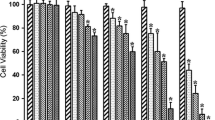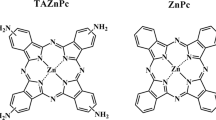Abstract
Photodynamic therapy (PDT) using photosensitizer induces several types of cell death, such as apoptosis, necrosis, and autophagy, depending on the PDT procedure, photosensitizer type, and cell type. We previously demonstrated that PDT using the photosensitizer talaporfin sodium (mono-l-aspartyl chlorine e6, NPe6; NPe6-PDT) induces both mitochondrial apoptotic and necrotic cell death in human glioblastoma T98G cells. However, details regarding the mechanism of necrosis caused by NPe6-PDT are unclear. Here, we investigated whether or not necroptosis, a recently suggested form of programmed necrosis, is involved in the necrotic cell death of NPe6-PDT-treated T98G cells. Leakage of lactate dehydrogenase (LDH) from the cell layer into conditioned medium was significantly increased by NPe6 (25 and 50 μg/ml)-PDT, indicating that NPe6-PDT induces necrosis in these cells. NPe6 (25 μg/ml)-PDT treatment also induced conversion of microtubule-associated protein 1 light-chain 3 (LC3)-I into phosphatidylethanolamine-conjugated LC3-II accompanying autophagosome formation, indicators of autophagy; however, of note, NPe6 (50 μg/ml)-PDT did not induce such autophagic changes. In addition, both necrostatin-1 (a necroptosis inhibitor) and knockdown of necroptotic pathway-related proteins [e.g., receptor interacting serine-threonine kinase (RIP)-1, RIP-3, and mixed lineage kinase domain-like protein (MLKL)] inhibited leakage of LDH caused by NPe6 (25 μg/ml)-PDT. Taken together, the present findings revealed that NPe6-PDT-induced necrotic cell death is mediated in part by the necroptosis pathway in glioblastoma T98G cells.




Similar content being viewed by others
References
Agostinis P, Berg K, Cengel KA, Foster TH, Girotti AW, Gollnick SO, Hahn SM, Hamblin MR, Juzeniene A, Kessel D, Korbelik M, Moan J, Mroz P, Nowis D, Piette J, Wilson BC, Golab J (2011) Photodynamic therapy of cancer: an update. CA Cancer J Clin 61(4):250–281
Buytaert E, Dewaele M, Agostinis P (2007) Molecular effectors of multiple cell death pathways initiated by photodynamic therapy. Biochim Biophys Acta 1776(1):86–107
Dolmans DE, Fukumura D, Jain RK (2003) Photodynamic therapy for cancer. Nat Rev Cancer 3(5):380–387
Lockshin RA, Zakeri Z (2004) Caspase-independent cell death? Oncogene 23(16):2766–2773
Mizushima N (2004) Methods for monitoring autophagy. Int J Biochem Cell Biol 36(12):2491–2502
Degterev A, Yuan J (2008) Expansion and evolution of cell death programmes. Nat Rev Mol Cell Biol 9(5):378–390
Leist M, Nicotera P (1997) The shape of cell death. Biochem Biophys Res Commun 236(1):1–9
Degterev A, Huang Z, Boyce M, Li Y, Jagtap P, Mizushima N, Cuny GD, Mitchison TJ, Moskowitz MA, Yuan J (2005) Chemical inhibitor of nonapoptotic cell death with therapeutic potential for ischemic brain injury. Nat Chem Biol 1(2):112–119
Vandenabeele P, Galluzzi L, Vanden Berghe T, Kroemer G (2010) Molecular mechanisms of necroptosis: an ordered cellular explosion. Nat Rev Mol Cell Biol 11(10):700–714
Kaczmarek A, Vandenabeele P, Krysko DV (2013) Necroptosis: the release of damage-associated molecular patterns and its physiological relevance. Immunity 38(2):209–223
Zhao J, Jitkaew S, Cai Z, Choksi S, Li Q, Luo J, Liu ZG (2012) Mixed lineage kinase domain-like is a key receptor interacting protein 3 downstream component of TNF-induced necrosis. Proc Natl Acad Sci U S A 109(14):5322–5327
Cai Z, Jitkaew S, Zhao J, Chiang HC, Choksi S, Liu J, Ward Y, Wu LG, Liu ZG (2014) Plasma membrane translocation of trimerized MLKL protein is required for TNF-induced necroptosis. Nat Cell Biol 16(1):55–65
Coupienne I, Fettweis G, Rubio N, Agostinis P, Piette J (2011) 5-ALA-PDT induces RIP3-dependent necrosis in glioblastoma. Photochem Photobiol Sci 10(12):1868–1878
Akimoto J, Haraoka J, Aizawa K (2012) Preliminary clinical report on safety and efficacy of photodynamic therapy using talaporfin sodium for malignant gliomas. Photodiagnosis Photodyn Ther 9(2):91–99
Miki Y, Akimoto J, Yokoyama S, Homma T, Tsutsumi M, Haraoka J, Hirano K, Beppu M (2013) Photodynamic therapy in combination with talaporfin sodium induces mitochondrial apoptotic cell death accompanied with necrosis in glioma cells. Biol Pharm Bull 36(2):215–221
Kabeya Y, Mizushima N, Ueno T, Yamamoto A, Kirisako T, Noda T, Kominami E, Ohsumi Y, Yoshimori T (2000) LC3, a mammalian homologue of yeast Apg8p, is localized in autophagosome membranes after processing. Embo J 19(21):5720–5728
Kessel DH, Price M, Reiners JJ Jr (2012) ATG7 deficiency suppresses apoptosis and cell death induced by lysosomal photodamage. Autophagy 8(9):1333–1341
Iwai-Kanai E, Yuan H, Huang C, Sayen MR, Perry-Garza CN, Kim L, Gottlieb RA (2008) A method to measure cardiac autophagic flux in vivo. Autophagy 4(3):322–329
Miki Y, Akimoto J, Hiranuma M, Fujiwara Y (2014) Effect of talaporfin sodium-mediated photodynamic therapy on cell death modalities in human glioblastoma T98G cells. J Toxicol Sci 39(6):821–827
Wang Z, Jiang H, Chen S, Du F, Wang X (2012) The mitochondrial phosphatase PGAM5 functions at the convergence point of multiple necrotic death pathways. Cell 148(1-2):228–243
Moujalled DM, Cook WD, Murphy JM, Vaux DL (2014) Necroptosis induced by RIPK3 requires MLKL but not Drp1. Cell Death Dis 5, e1086
Firczuk M, Nowis D, Golab J (2011) PDT-induced inflammatory and host responses. Photochem Photobiol Sci 10(5):653–663
Ogawa A, Wada T, Tedo T, Namiki T (1979) Delayed radiation necrosis of the brain. Neurol Med Chir (Tokyo) 19(4):367–372
Acknowledgments
Talaporfin sodium (NPe6) was provided by Meiji Seika Pharma Co., Ltd. (Tokyo, Japan). The semiconductor laser irradiation device was provided by Panasonic Healthcare Co., Ltd. (Ehime, Japan).
Conflict of interest
The authors declare no conflicts of interest.
Author information
Authors and Affiliations
Corresponding author
Rights and permissions
About this article
Cite this article
Miki, Y., Akimoto, J., Moritake, K. et al. Photodynamic therapy using talaporfin sodium induces concentration-dependent programmed necroptosis in human glioblastoma T98G cells. Lasers Med Sci 30, 1739–1745 (2015). https://doi.org/10.1007/s10103-015-1783-9
Received:
Accepted:
Published:
Issue Date:
DOI: https://doi.org/10.1007/s10103-015-1783-9




